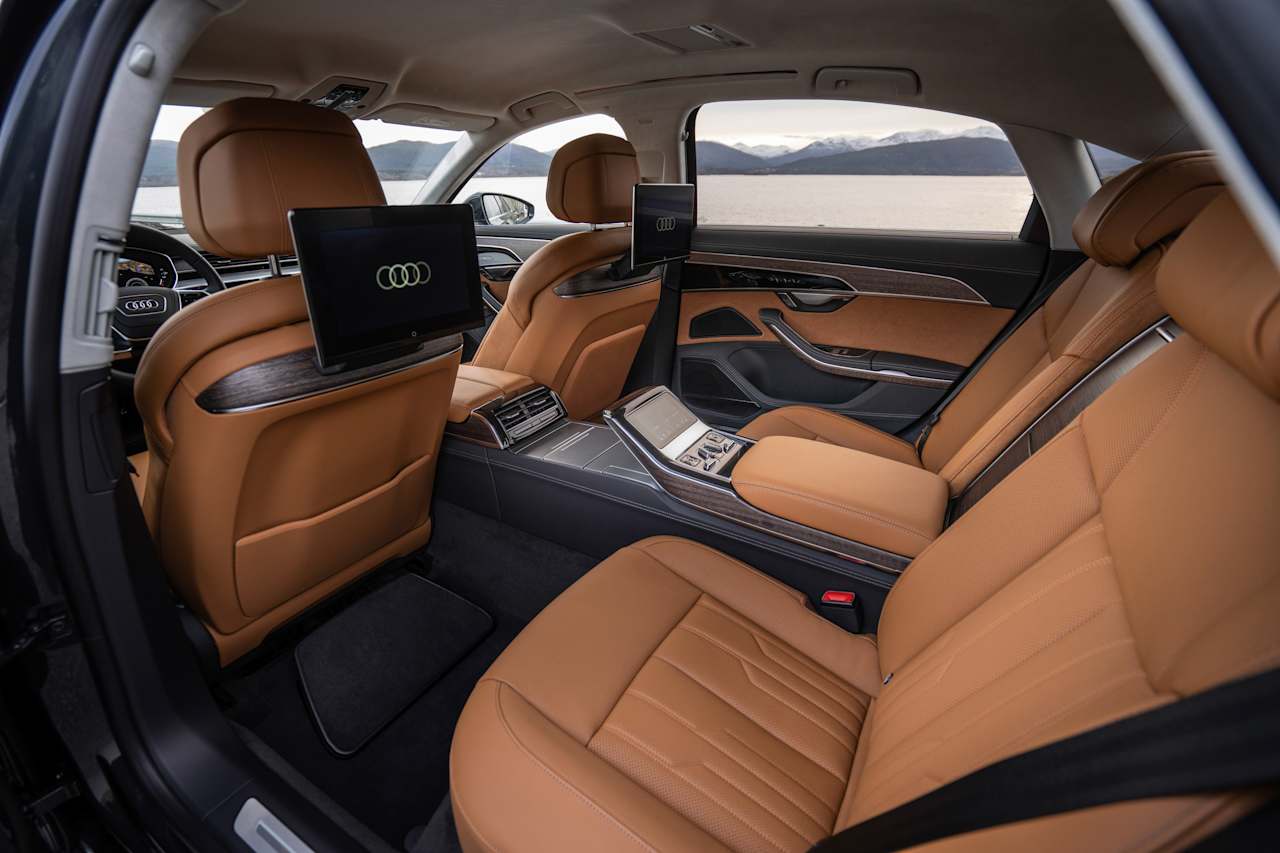From world rally, sports and touring car success, Audi has motorsport and performance embedded in its DNA. So, no surprise Audi chose Phillip Island for the Australian launch of its TT RS.
Think of Audi and the image of a sleek SUV is the one most likely to pop into your mind. The compact Q3 currently runs neck-and-neck with its A3 sibling as the brand’s top seller in Australia, while the mid-size Q5, and seven seat Q7 SUVs also rack up substantial numbers.
But from the Auto Union ‘Silver Arrows’ of the 1930s, to world rally, sports and touring car success, Audi has motorsport and performance embedded deep in its DNA.
No surprise then, that Audi chose the sensational Phillip Island race circuit for the Australian launch of its much-anticipated TT RS.
Arriving 18 months after the launch of the third-gen regular TT range, the new RS is powered by a further developed version of its signature 2.5-litre, five cylinder turbo-petrol engine, and its abilities have pushed it into an even higher league.
This time around the finely-tuned TT is offered in Coupe and Roadster form, and on paper, goes head-to-head with its VW Group cousins, Porsche’s 718 Cayman S and Boxster S.
Does the RS’s distinctive design and impressive spec translate into a driving experience capable of knocking off Stuttgart’s mid-engine duo? Stay tuned, as we hit the road and track to find out.
Audi TT 2017: Rs Quattro
| Engine Type | Turbo 5, 2.5L |
|---|---|
| Fuel Type | Premium Unleaded Petrol |
| Fuel Efficiency | 8.4L/100km (combined) |
| Seating | 4 |
| Price From | $62,920 - $72,270 |
Is there anything interesting about its design?
8 / 10
Close to 20 years ago you could hear the collective gasp as car-spotters around the world first caught sight of the original Audi TT.
.jpg)
It was one of the most innovative automotive designs of the late 20th century, and as time ticked by the big question became, how do you evolve such a ground-breaking shape?
Several ‘how not to do this’ case-studies are on the public record, with the sublime Datsun 240Z, through lengthened and less agile 260Z 2+2, to bloated and ponderous 280Z, being a prime example. Kind of Elvis on wheels.
.jpg)
But somehow Audi has managed to avoid that syndrome and maintain the spirit of the original while gradually morphing the TT into a wider, lower, slicker version of itself.
The third-gen TT wears an evil-eyed, angry expression, with the relatively small glasshouse enhancing the profile’s smooth curvature.
Broad, bold surfaces are beautifully controlled, while the RS’s standard 20-inch rims, and cheeky fixed rear wing add an appropriate sense of menace to an already purposeful stance.
And the RS’s stunning form delivers efficient aero function. A large front splitter and serious diffuser at the rear are clues to careful management of the air flowing under the car as much as that passing over it, and the result is a handy drag coefficient (Cd) of 0.32 for the Coupe, and 0.33 for the Roadster.
Inside is all business, with typical Audi efficiency applied to the key controls and instruments, while brushed metal elements (carbon optional) add a suitably racy feel.
.jpg)
The centre console is subtly angled towards the driver, and the Audi design team has again managed to develop TT-esque elements like the five, circular ventilation outlets, into new but familiar features of the current interior.
How practical is the space inside?
6 / 10
The four-seat TT coupe provides generous space for the driver and front passenger, and unlike some others fitting the ‘2+2’ description, getting in and out (of the front) is a breeze.
In terms of storage, there’s a glovebox, plus a small lidded box in the console, storage drawers under the seats, and bins in the doors, although the latter are just large enough to accommodate a small drink bottle (lying on its side). And if you and your front passenger have stopped to pick up a take-away coffee there’ll be an arm wrestle over the single cup holder in the centre console.
.jpg)
There are two USB inputs and an auxiliary-in socket located in a tissue box-sized storage space hidden under a sliding lid in front of the gearshift.
A charitable person might describe the TT coupe’s rear accommodation - the convertible is a strict two-seater - as cozy, but frankly, it’s tight. It's a scramble to get in, and head and legroom for anyone beyond Year 8 is going to be distinctly uncomfortable. A UN-style negotiation will be required between front and rear occupants to set up a mutually habitable arrangement.
There are outer armrests back there, with oddments trays underneath, but you’re looking at a 100 per cent deficiency in the cupholder department, and no specific ventilation outlets.
But if you really want to get practical and sensible, there’s a generous 305-litre boot (280 in the convertible), with that space more than doubling to 712 litres with those pesky rear seats folded forward. There’s also a 12 volt outlet in there.
There’s no spare tyre. Just a ‘tyre repair kit’, more commonly known as a ‘can of goo’.
Does it represent good value for the price? What features does it come with?
7 / 10
As you might expect, at $137,900 for the Coupe, and $141,900 for the Roadster (before on-road costs) the TT RS boasts a lengthy standard equipment list including, electrically adjustable and heated ‘RS’ sport front seats with electric lumbar support and pneumatic adjustment for the backrest side bolsters.
The interior, including the seats, door armrests, door pull handles and centre console, is trimmed in nappa leather with nifty diamond pattern stitching on the centre of the front chairs.
An electrically controlled wind deflector and three-stage neck-level heating for the front seats are standard in the Roadster.
You can also expect, cruise control, keyless entry and start, LED headlights, daytime running lights and tail-lights, tinted ‘privacy’ glass, climate control air, ambient lighting, rain-sensing wipers and auto headlights (including auto high beam), nine-speaker/155 watt audio, Apple CarPlay and Android Auto integration, plus sat nav including ‘MMI Touch’ functionality and live traffic updates.
Add in the outstanding 12.3-inch, configurable ‘Virtual Cockpit’ display, plus all the safety gear detailed further down, and you’re looking at a solid basket of standard fruit.
Three option packs are available – ‘Advanced Lighting’, which includes Matrix LED headlights, the ‘RS Catalunya red design package’, which as the name implies, adds red highlights to various interior pieces including the air vents, seatbelts and floor mats, plus the ‘RS Nardo grey design package’, which swaps out red for grey highlights.
There are eight exterior colours offered, with ‘Nardo Grey’ the only no-cost option. Choose a metallic shade and you’re up for $1300, with a ‘crystal effect’ finish adding $2000 to the price tag.
What are the key stats for the engine and transmission?
9 / 10
The latest (07K3) version of Audi’s all-alloy 2.5-litre turbo-petrol in-line five cylinder engine is 26kg lighter than the previous version, thanks largely to the addition of an alloy crankcase, and hollow-bored crankshaft.
The ‘Audi valvelift system’ (AVS) operates on the exhaust side to optimise fuel consumption under low or partial loads, and retain the ability to sharpen throttle response and maximise power at full noise.
.jpg)
A range of other upgrades include plasma coated cylinder bores to reduce internal friction, and dual injection which can send fuel into the intake manifold as well as directly into the combustion chamber.
Net result is a 17 per cent power increase, to 294kW at 5850-7000rpm, and maximum torque (480Nm) delivered from just 1700, all the way to 5850rpm. Talk about a beautifully dovetailed dyno sheet.
All that grunt gets to the ground via a new, lighter seven-speed dual clutch gearbox feeding the latest iteration of Audi’s 'quattro' adaptive all-wheel drive system, with an electronic differential lock (EDL) and wheel-selective torque control in support.
How much fuel does it consume?
8 / 10
Despite its fire and brimstone performance potential the TT RS’s fuel consumption is suitably planet-friendly.
A claimed combined (urban/extra urban) figure of 8.4L/100km is good going for a car this quick, with the tailpipe emitting 192 g/km of CO2 in the process.
Fuel requirement is 98RON premium unleaded, with 55 litres of it required to fill the tank.
Given a large part of this launch first drive was spent ‘pushing on’ through challenging open roads, and hammering around the 4.5km Phillip Island circuit, we didn’t record a test economy figure.
What's it like to drive?
8 / 10
Slip into the grippy RS sports seats, and you’re presented with a chunky sports wheel, complete with manual shift paddles, and Audi’s brilliant virtual cockpit, with additional RS-specific screens for tyre pressure, torque, and g-force.
To go with the RS’s extra power Audi has added lightness, the Coupe dropping to 1440kg (-35kg) and the Roadster weighing in at 1530kg.
.jpg)
As a result, acceleration is supercar rapid, with the Coupe blasting from 0-100km/h in just 3.7sec, while the head-turning, but slightly heavier Roadster takes 0.2sec longer to hit the same number.
And speed is nothing without sound (I’m talking to you Formula E and Elon Musk). The in-line five emits a characteristically guttural growl, with a console switch opening tabs in the exhaust to enhance a spine-tingling howl at the top end.
Speaking of which, in manual mode a shift indicator function in the tacho adds an extra level of engagement by lighting up from 5000rpm through green, amber, and ultimately red segments, before the entire dial blinks manically on arrival at the 7000rpm rev ceiling. Nice touch.
The RS is underpinned by the ultra-stiff Audi Space Frame chassis, and sits 10mm lower than the standard car, with strut front and four-link rear RS Sport suspension, plus ‘Magnetic Ride’ adaptive damper control standard.
Audi Drive Select manages the engine, transmission, steering, dampers and diff to offers four modes – Comfort, Auto, Dynamic and Individual.
For Australia, standard rims are 20-inch alloys shod with high-performance 255/30 x 20 Yokohama Advan or Pirelli P Zero rubber. The RS steering is re-tuned for more direct response, and the ESC boasts specific RS settings.
Sport delivers later ESC intervention, and you can give the fun police a send-off by switching it off altogether.
On the open road, with masses of mid-range torque, and heaps of top end power, the TT RS is a rapid and refined point-to-point projectile, with the ability to settle down into a comfortable, quiet city and suburban daily driver when required.
The shift from Dynamic to Comfort mode transforms the ride quality from hard and jittery to smooth and comfy almost instantly, and with the exhaust in a similarly polite setting the TT RS is ready to eat up a peak hour commute.
On the subject of polished behaviour, the Roadster, if a little louder to ride in, is the equal of the Coupe dynamically, and its automatic Z-fold acoustic soft top opens or closes in 10 seconds at speeds up to 50km/h. Very civilised.
Around Phillip Island the TT RS is composed and balanced at speeds that would see lesser machines spinning off into the weeds. We took a quick peek and saw 245km/h (just five kays off the electronically-limited maximum) staring back at us on entry to the braking zone for turn one.
You can feel the quattro system and its connected electronic wizardry keeping the car in a stable state with the steering communicating every movement through the imposing layout’s seriously quick, sweeping corners.
The electromechanically-assisted, variable ratio steering has a satisfyingly direct connection with the front wheels, without a hint of shock or unnecessary reaction, and the Pirelli P Zero rubber (fitted to our car) is superb.
And on a circuit as epic as ‘the island’ big speed needs to be matched with big brakes and thanks to massive ventilated 370mm discs with eight piston calipers at the front, and 310mm solid rotors at the rear, the RS washes off speed with consistent authority.
Warranty & Safety Rating
What safety equipment is fitted? What safety rating?
7 / 10
On the active side of the safety equation the TT RS features ‘Attention assist’ (alert tone and visual signal if system determines the driver’s attention may be lapsing), ‘Active lane assist’ (corrective steering intervention and steering vibration), ‘Side assist’ (blind spot warning), a tyre pressure monitoring system, Electronic Stabilisation Control (ESC) with electronic wheel-selective torque control, ABS, ASR, EDL and Brake Assist. But no AEB.
If all that isn’t enough to keep you out of trouble there are airbags aplenty; specifically, six in the Coupe (dual front, side and curtain), and four on the Roadster (dual front and side). Given the obvious inability to equip the Roadster with curtain bags, its side airbags are shaped to inflate higher, to better protect the head and thorax.
The TT RS also features an active bonnet to minimise injury in a pedestrian collision, but despite ISOFIX child restraint location points in each rear seat position, “inadequate child protection” and that lack of AEB, caused ANCAP to rate the TT coupe four from a possible five stars in 2015 testing.
What does it cost to own? What warranty is offered?
7 / 10
Audi offers a three year/unlimited km warranty, with three years paint protection and a 12 year rust perforation warranty also included.
Service is recommended every 15,000km or 12 months, whichever comes first, but Audi’s ‘Genuine Care’ fixed price service program isn’t available on RS models.
Verdict
The Audi TT RS is faster, more focused, and even more desirable than the excellent second-gen version it replaces. Is it a 718 Boxster/Cayman crusher? The answer boils down to single-minded purpose versus all-around ability. The price and performance may be comparable, but the Porsches are purer sports cars, relative to TT RS’s broader, multi-purpose personality. Not a bad choice if you’re in the happy position to make it. All we can say is steer this brilliant Bavarian before you settle on Stuttgart’s finest.









.jpg)


.jpg)
.jpg)